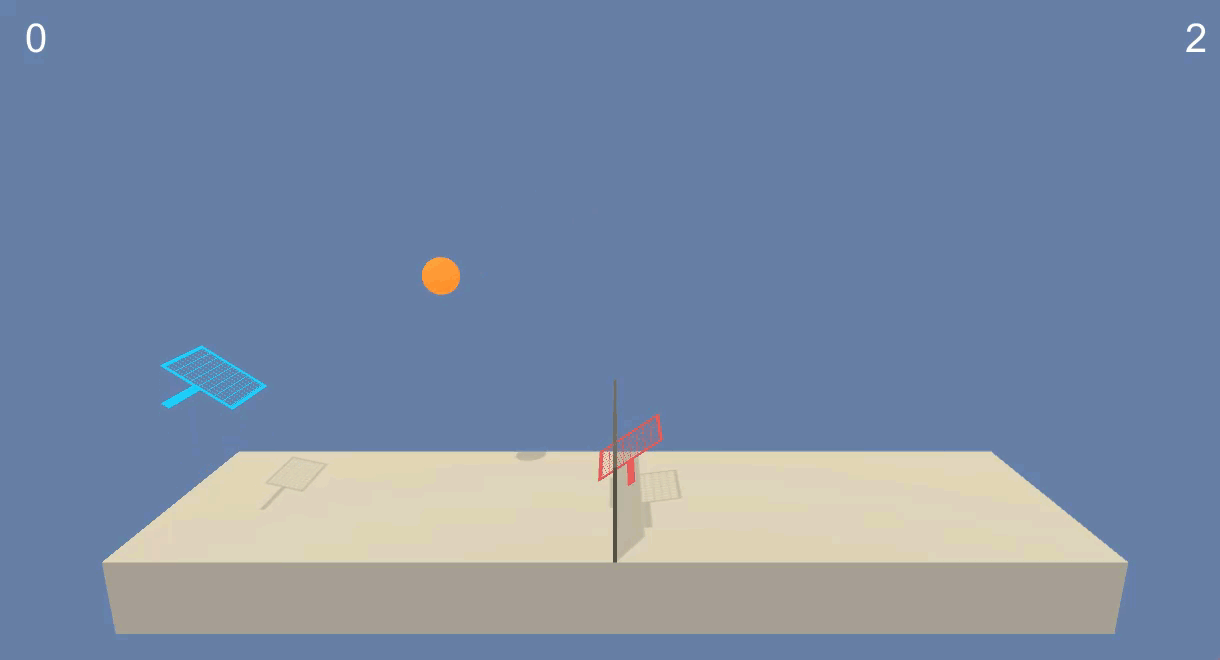In this project, we will solve the Unity Tennis environment.
In this environment, two agents control rackets to bounce a ball over a net. If an agent hits the ball over the net, it receives a reward of +0.1. If an agent lets a ball hit the ground or hits the ball out of bounds, it receives a reward of -0.01. Thus, the goal of each agent is to keep the ball in play.
The observation space consists of 8 variables corresponding to the position and velocity of the ball and racket. Each agent receives its own, local observation. Two continuous actions are available, corresponding to movement toward (or away from) the net, and jumping.
The task is episodic, and in order to solve the environment, the agents must get an average score of +0.5 (over 100 consecutive episodes, after taking the maximum over both agents). Specifically,
- After each episode, we add up the rewards that each agent received (without discounting), to get a score for each agent. This yields 2 (potentially different) scores. We then take the maximum of these 2 scores.
- This yields a single score for each episode.
The environment is considered solved, when the average (over 100 episodes) of those scores is at least +0.5.
- Clone this repository, and navigate to the
MultiAgentDDPG/folder. Then, install several dependencies.
git clone https://github.com/primeMover2011/MultiAgentDDPG.git
cd MultiAgentDDPG-
Download the environment from one of the links below. You need only select the environment that matches your operating system:
- Linux: click here
- Mac OSX: click here
- Windows (32-bit): click here
- Windows (64-bit): click here
(For Windows users) Check out this link if you need help with determining if your computer is running a 32-bit version or 64-bit version of the Windows operating system.
(For AWS) If you'd like to train the agent on AWS (and have not enabled a virtual screen), then please use this link to obtain the "headless" version of the environment. You will not be able to watch the agent without enabling a virtual screen, but you will be able to train the agent. (To watch the agent, you should follow the instructions to enable a virtual screen, and then download the environment for the Linux operating system above.)
-
Extract the contents of the file to a folder of you choice, preferably as a subfolder of this repository.
- Install conda
cd in to the directory where you cloned this repository, create a virtual environment and install the required python packages using these commands
cd MultiAgentDDPG
conda env create -f environment.yml- activate the environment using
conda activate MultiAgentDDPG- update the location of the environment in main.py and in test.py
env = UnityEnvironment(file_name='YOUR_PATH_HERE', base_port=64739)- Watch the pretrained agent.
python test.py- Train your own agent using default parameters.
python main.py- Read the report and play around with the code, change some hyperparameters!
in main.py change
scores_all, moving_average = experiment(n_episodes=20000, ou_noise=2.0, ou_noise_decay_rate=0.998, train_mode=True,
threshold=0.5, buffer_size=1000000, batch_size=512, update_every=2, tau=0.01,
lr_actor=0.001, lr_critic=0.001)
